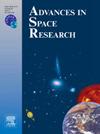多gnss单频SPP中电离层校正模型的评价
IF 2.8
3区 地球科学
Q2 ASTRONOMY & ASTROPHYSICS
引用次数: 0
摘要
全球导航卫星系统(GNSS)的定位精度主要受到电离层延迟的不利影响。在单频单点定位(SF-SPP)解决方案中,这些影响通常通过使用电离层校正模型来减轻。为此,GNSS卫星开发并播送了各种电离层模型。它们分别包括Klobuchar、NeQuick-G/NTCM-G和BDGIM,分别用于GPS、伽利略和BDS-3系统。此外,国际GNSS服务(IGS)实时服务(RTS)项目使实时全球电离层地图(RT-GIMs)的开发成为可能,该地图也可以支持实时定位。考虑到电离层延迟对卫星导航定位误差的显著影响,分析现有电离层模型的精度至关重要。因此,基于30个IGS站点的多gnss观测数据,对SF-SPP电离层校正模型的性能进行了评估。在本研究中,使用精确的大地测量产品来减少几何误差源对定位解的影响,从而强调电离层模型的影响。这些分析是在2020年的两个月期间进行的,标志着第25个太阳周期的开始。定位结果显示电离层校正模型在不同修正倾角(MODIP)纬度区域的性能差异较大。在广播模型中,ntm - g模型获得了最好的结果,与未校正的解决方案相比,定位精度平均提高了64%。然而,RT-GIM允许72%的更好的改进,证实了IGS RTS产品对SF-SPP的良好适用性。本文章由计算机程序翻译,如有差异,请以英文原文为准。
Evaluation of ionospheric correction models in multi-GNSS single-frequency SPP
The accuracy of Global Navigation Satellite System (GNSS) positioning is primarily limited by the adverse effects of ionospheric delays. In single-frequency single point positioning (SF-SPP) solutions, these effects are typically mitigated through the utilization of ionospheric correction models. For this purpose, a variety of ionospheric models are developed and broadcast by GNSS satellites. They include Klobuchar, NeQuick-G/NTCM-G, and BDGIM for GPS, Galileo, and BDS-3 systems, respectively. Moreover, the International GNSS Service (IGS) Real-Time Service (RTS) project has enabled the development of Real-Time Global Ionosphere Maps (RT-GIMs), which can also support real-time positioning. Given the significant impact of ionospheric delay on satellite navigation positioning errors, it is crucial to analyze the accuracy of the available ionospheric models. Therefore, based on multi-GNSS observations obtained from 30 IGS stations, the performance of the ionospheric correction models in SF-SPP is assessed. In this study, precise geodetic products are employed to reduce the influence of geometry-related error sources on the positioning solution and, hence, to emphasize the impact of the ionosphere models. The analyses are performed for the two-month period in 2020 marking the beginning of the 25th solar cycle. The positioning results revealed large discrepancies in the performance of the ionospheric correction models over different modified dip (MODIP) latitude regions. Among the broadcast models, the best results are obtained for the NTCM-G model, achieving an average 64% improvement in positioning accuracy compared to the uncorrected solution. However, RT-GIM allowed for an even better improvement of 72%, confirming the favorable applicability of the IGS RTS products to SF-SPP.
求助全文
通过发布文献求助,成功后即可免费获取论文全文。
去求助
来源期刊

Advances in Space Research
地学天文-地球科学综合
CiteScore
5.20
自引率
11.50%
发文量
800
审稿时长
5.8 months
期刊介绍:
The COSPAR publication Advances in Space Research (ASR) is an open journal covering all areas of space research including: space studies of the Earth''s surface, meteorology, climate, the Earth-Moon system, planets and small bodies of the solar system, upper atmospheres, ionospheres and magnetospheres of the Earth and planets including reference atmospheres, space plasmas in the solar system, astrophysics from space, materials sciences in space, fundamental physics in space, space debris, space weather, Earth observations of space phenomena, etc.
NB: Please note that manuscripts related to life sciences as related to space are no more accepted for submission to Advances in Space Research. Such manuscripts should now be submitted to the new COSPAR Journal Life Sciences in Space Research (LSSR).
All submissions are reviewed by two scientists in the field. COSPAR is an interdisciplinary scientific organization concerned with the progress of space research on an international scale. Operating under the rules of ICSU, COSPAR ignores political considerations and considers all questions solely from the scientific viewpoint.
 求助内容:
求助内容: 应助结果提醒方式:
应助结果提醒方式:


